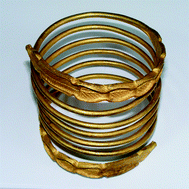This paper is an overview of the work developed by our group in the investigations of museum objects and alluvial gold, reflected in a series of studies published between 2000–2011, supplemented with new results, unpublished up-to-date. The X-ray based spectrometric techniques employed range from various X-Ray Fluorescence (XRF) investigations to ion beam analysis, including synchrotron radiation XRF and micro-Particle Induced X-ray Emission. The gold objects discussed are mainly part of the Sarmizegetusa Dacian hoards—spiraled bracelets (armbands) and coins. After obtaining in 2011 the permission of the Romanian authorities to take very small (1–2 mg) samples from the most “unimportant” areas of the Dacian bracelets and several Koson staters, to analyze them by micro-SR-XRF at BESSY, in February 2012, the investigation of several micro-areas of 17 stater and 28 bracelet samples revealed important micro-structural inhomogeneity, especially in Sn and Cu. The same inhomogeneous micro-structure has been seen in Transylvanian alluvial gold. The analyses revealed details on the fingerprint of geological gold deposits and also the main characteristics of ancient gold metallurgy procedures used by the Dacians: a relatively low temperature (lower than Au melting point) and hammering during heating to obtain an ingot through sintering. The use of the sintering procedure was proved for the spiraled bracelets and the Koson without monogram coins, a tradition starting in the Bronze Age in Transylvanian gold processing. The existence of micro-inclusions of Ta-minerals in alluvial gold was also detected, explaining Ta trace presence in the artifacts from the Pietroasa hoard.

You have access to this article
 Please wait while we load your content...
Something went wrong. Try again?
Please wait while we load your content...
Something went wrong. Try again?


 Please wait while we load your content...
Please wait while we load your content...